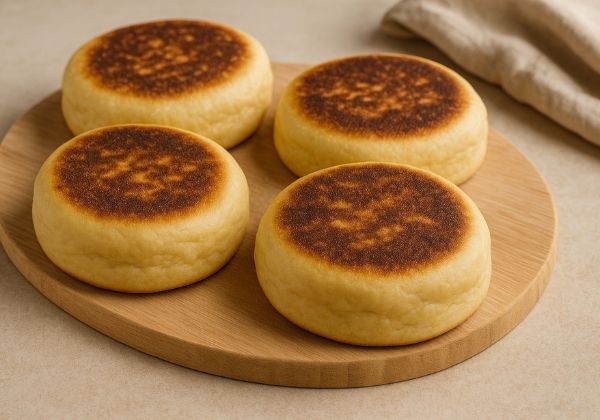If you’ve never heard of Bolo Levedo, get ready to meet your new breakfast favorite. These Portuguese muffins (also known as Bolos Levedos) are sweet, soft, and slightly crunchy cakes, similar to flatbreads—somewhere between a sweet bread and an English muffin, but with a distinct flavor and texture that make them completely unique.
Popular in the Azores, this traditional recipe is a staple in Portuguese homes and is often enjoyed warm with butter, jam, or even used as a soft bun for burgers and sandwiches.
In this blog, we’ll delve into how to make this yeast cake recipe from scratch in your own kitchen. Whether you’re an amateur cook or just exploring Portuguese recipes, this is one to bookmark. Let’s get cooking!
Ingredients you will need
Before you begin, gather these simple, everyday ingredients. No special tools—just a large bowl, a frying pan, and your love of baking!
- 1 tablespoon of dry yeast
- ¼ cup warm (not hot!) water
- 1 cup of warmed milk
- 3 tablespoons melted butter
- 2 large eggs at room temperature
- ½ cup sugar
- 4 cups all-purpose flour (plus a little for dusting)
- ½ teaspoon salt
- A little oil or butter to grease the pan
Tip: Want a softer dough? Add 1 tablespoon of potato flour or use a mixture of bread flour and all-purpose flour for a softer texture.
Step-by-step instructions
1. Activate the yeast
In a small bowl, combine the dry yeast with the warm water. Let it sit for 10 minutes until a foamy dough forms. This is the yeast mixture that gives your cakes that airy texture.
2. Prepare the dough
In a large bowl, whisk together the milk, melted butter, eggs, and sugar until well combined. Add the foamy yeast mixture.
Gradually add the flour and salt, stirring until a sticky dough forms. You can use a stand mixer with a dough hook on low speed or mix by hand.
3rd fermentation (let the dough rise)
Cover the bowl with plastic wrap or a clean dish towel. Place it in a warm place and let the dough rise for 2 to 3 hours, until doubled in size.
4. Shape the muffins
Turn the dough out onto a floured surface and gently turn it over. Don’t overwork it, just enough to release large air bubbles. Divide the dough into small balls (about 12 to 14). Roll each ball into a compact ball and gently flatten it into discs about 1/2 inch thick.
You’re creating those yeast-leavened cakes, those typical round, flat cakes.
5. Second fermentation
Place the discs on a floured baking sheet and cover again with a cloth. Let them rest for another 30 to 60 minutes (second proofing) to make them even fluffier.
6. Roast in a frying pan
Heat a nonstick skillet or griddle over low heat. Lightly grease with butter or oil.
Carefully place each dough disk in the skillet and bake for 5 to 7 minutes per side, or until golden brown and cooked through. Avoid high heat, as it will burn the outside before the inside is done.
Repeat until all muffins are cooked.

How to Serve Yeast Cake
These sweet muffins are super versatile. Enjoy them:
- Hot with butter and honey
- Toast with eggs and cheese for a hearty breakfast
- Divided and used as hamburger buns
- Stuffed with meatballs or pulled pork to add a special touch to pita bread sandwiches
- Dusted with cinnamon sugar for a dessert-style snack
Storage and Reheating Tips
- Store in an airtight container at room temperature for up to 3 days.
- Freeze in batches with parchment paper between each muffin for easy access.
- To reheat, toast them or heat them in a dry skillet over low heat.
Nutritional Information (Approximately per Muffin)
| Nutritious | Amount |
| Calories | 190 |
| Carbohydrates | 32g |
| Proteins | 5g |
| Fats | 4g |
| Sugars | 8g |
Based on a batch of 12 muffins. Prices may vary depending on size and ingredients.
Final Thoughts: A Homemade Taste of Portugal
There’s a reason bolo levedo has won the hearts of food lovers around the world. It’s more than just a Portuguese muffin—it’s a comforting, slightly sweet, and soft bread that brings warmth to your table.
Whether you’re baking with the family, exploring international flavors, or simply trying something new for your next breakfast, this recipe adds a Portuguese touch to your meal.
Next time you’re in the kitchen, try this traditional favorite—you might just make it a permanent part of your baking routine!
What did you think?
Have you tried this delicious yeast cake recipe at home? Do you have any tips, variations, or stories to share? Leave a comment below—we love hearing from other home cooks and recipe adventurers !




